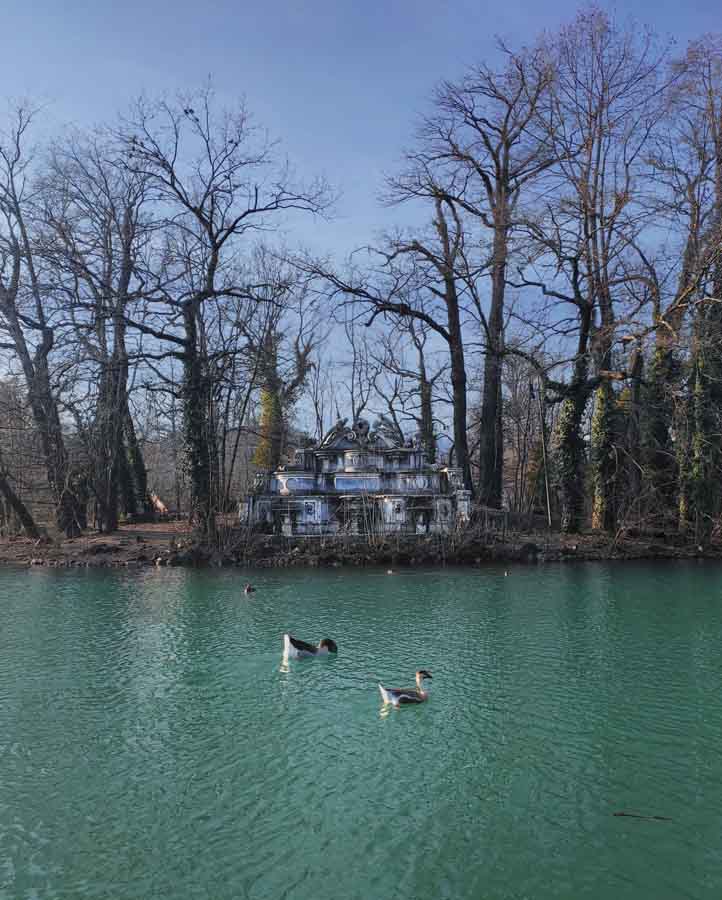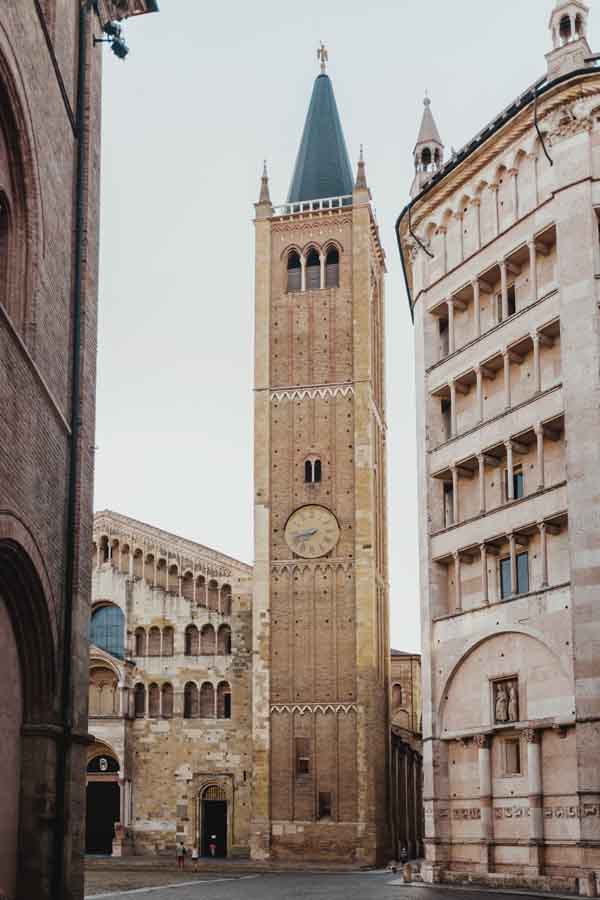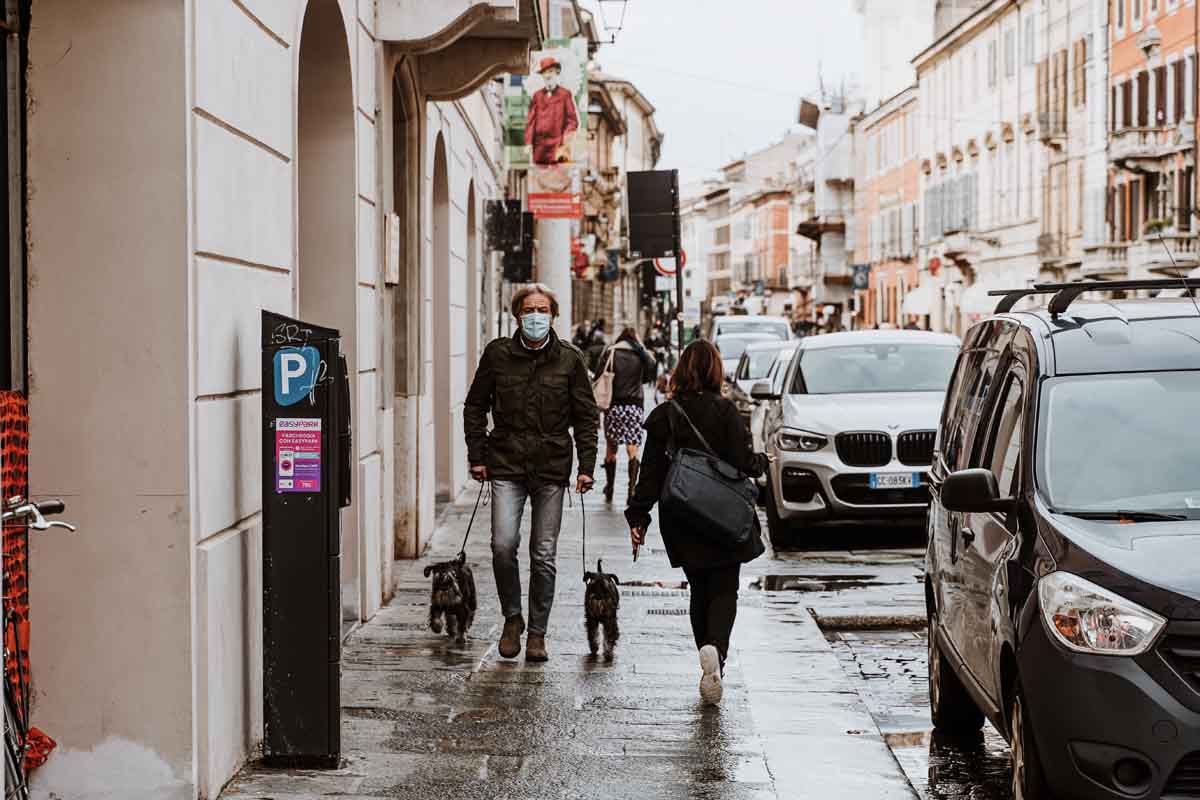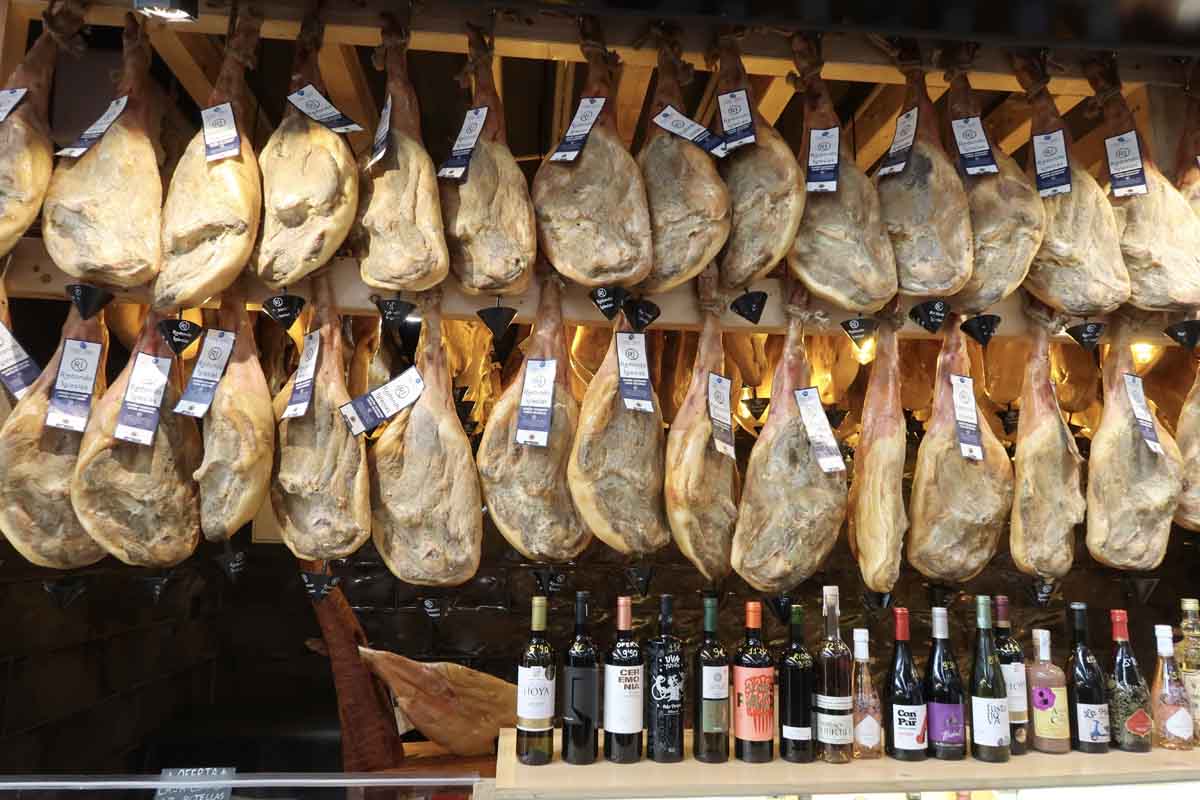Are you a food lover? Well then you HAVE to visit Parma! Let’s discover 23 things to do in Parma, including where to eat!
Are you visiting for the first time? Book your Parma tour here!
We love tours with GetYourGuide – tours are run by locals and they offer a variety of activities, flexible booking, and 24/7 support!
- Parma: Parmigiano Production and Parma Ham Tour & Tasting – learn about how prosciutto and parmesan are made (with a glass of wine!)
- From Parma: Parmesan, Parma Ham & Balsamic Vinegar Tour – a full-day experience to discover the best Parma food!
- Parma City Walking Tour – a guided walk around the center with a local guide
- Parma: Winery Tour and Tasting – this area is also known for wine!
- Parma: Dining Experience at a Local’s Home – in Italy, everybody knows the best food is the one you have at home!
Ok, I started our article about the best things to do in Modena in the same way, but if you’ve landed here, I’m sure this question will be milling around your head.
Is Parma worth visiting? Well, YES! Definitely yes! Parma is not just a pleasant small town, filled with interesting museums, sunny squares, and other interesting sights, it’s also one of the most interesting food cities in Italy. You know PARMigiano Reggiano and PARMA ham? They’re from Parma, of course – you can visit food factories and learn how these delicious products are made!
Parma cuisine offers a lot more than prosciutto and cheese – including the truly unique specialty we’ve highlighted at number 22, which we dare you to try! Jokes aside, whether you are planning to visit as a day trip from Bologna, for a food-focused weekend or a culture break, there is really something for everyone in Parma.
Here we’ve listed 21 of the best things to do in Parma, perfect if it’s your first visit!

Free Things to do in Parma
1) Duomo di Parma (Cattedrale di Santa Maria Assunta)
Also known as the Duomo di Parma, the Cattedrale di Santa Maria Assunta is the city’s most important place of worship. The building is located in Piazza Duomo, near the Battistero and the Palazzo del Vescovo. Architecturally, the Cathedral has a facade built in the Romanesque style, typical of the 11th century.
The Romanesque style was also used for the interior, with a Latin cross structure formed by three naves. The central nave is the largest, with walls adorned with several frescoes painted in the 16th century by Lattanzio Gambara, representing episodes from the Old and New Testaments.
The most important work of art in the cathedral is the Assunzione della Vergine (Assumption of the Virgin), a spectacular painting by Correggio located in the dome, created between 1525 and 1530. The Assunzione della Vergine is considered one of the masterpieces of Italian art, a depiction of the Virgin Mary surrounded by Apostles and angels, with the patron saints of the city of Parma painted in the corners.
2) Piazza Garibaldi
Parma’s main square, Piazza Garibaldi is the crossroads of the city’s axes, as well as a meeting place. The square is home to the Palazzo Comunale, a building constructed in the 13th century by combining Baroque and neoclassical architecture, which was known by the name Palazzo dei Mercanti.
In Piazza Garibaldi you can find several restaurants and bars that also have outdoor tables in summer. This is a great place to stop and relax before setting off to explore the city.
3) Botanical Garden
Visiting parks and gardens is also one of the best free things to do in Parma! The Giardino Botanico (Botanical Garden) of the city is part of the university grounds, and is a great place to escape if you’re looking for nature and silence.
In our article about non-touristy things to do in Bologna we’ve spoken about the custom of universities to have botanical gardens in the past, to grow medicinal plants for their pharmacology departments. Nowadays, the collection of plants found on the grounds includes exotic species gifted as part of University exchange programs, as well as fountains and ponds with water lilies.
4) Parco Ducale
This is THE park in Parma, housing Palazzo Ducale which is better described later on in the Museums section.
Parco Ducale is one of Parma’s most important green spaces, adorned with sculptures by artists ranging from the 16th to the 18th century. The park is a great place for a relaxing stroll and has several facilities such as cafes with tables, benches, children’s areas, and dog areas.
One of the most notable sights you can’t miss is the Trianon Fountain, where you can also see fish and turtles – all around, you can see the combination of wild nature and Italian-style garden which makes this park such a special place.

Things to Do in Parma – Museums and Culture
5) Baptistery
Located in the northern part of Piazza Duomo, the Baptistery was built between the 11th and 12th centuries, becoming a transition point from Romanesque to Gothic architecture. And indeed, the building combines the two styles, in an octagonal structure made of pink marble.
The Baptistery has three gates: Porta della Vergine on the north side of the building, Porta del Giudizio that faces the west, and Porta dell’Amore in the southern part. The Gothic style can be observed in the ogival vault. Inside the Baptistery it is possible to observe sculptures based on the cycle of the months and seasons, as well as sculptures of the various signs of the zodiac.
Though not as spectacular as the Duomo, the dome of the Baptistery is also worth visiting, as it is characterized by sixteen tubular lines forming a sunburst in the center, decorated with paintings.
6) Diocesan Museum
The Museo Diocesano (Diocesan Museum), opened in 2003, contains the various archaeological artifacts found in the Duomo of Parma and the Baptistry. The museum tour has visitors going through the history of how Christianity spread in the city of Parma, from Roman times to the early Middle Ages.
The museum contains several important exhibits, such as L’Angiol D’Or, a 1.42 meter-high statue representing archangel Raphael, as well as two other statues depicting archangels Raphael and Gabriel. Other sculptures include that of King Solomon and the Queen of Sheba. The museum also contains mosaics and capitals found during excavations in Piazza Duomo.
You can visit both the baptistery and the Diocesan Museum with a combo ticket at a cost of €12 per adult.

7) Palazzo della Pilotta
Known simply as the Pilotta, it was built in the late 16th century by the second Duke of Parma, Ottavio Farnese. And indeed, the Palazzo della Pilotta represented the ducal power of the Farnese family over the city of Parma. After the Farnese, the palace was partially abandoned, only to be recovered by Philip I of Bourbon, who initiated the restoration and rebirth of the building that continued over the years, until the the present day.
The palace was gradually transformed into a monumental complex, worth visiting if you are an art enthusiast. The complex includes the Teatro Farnese, Galleria Nazionale di Parma, Museo Archeologico Nazionale, and Biblioteca Palatina.
8) Teatro Farnese
Built in 1618 by Giovan Battista Aleotti by order of Ranuccio Farnese, the Teatro Farnese replaced the armory of the Palazzo della Pilotta. The Teatro Farnese brought several innovations, such as a mobile stage layout structure and machines that allowed characters to move upward.
Thanks to a flooding system, the theater could be filled with water, in order to stage naval battles. The structure was used until 1732, before its total abandonment. During World War II, the theater was destroyed, only to be rebuilt between 1956 and 1960, while performances resumed only in 1990s.
9) Galleria Nazionale
Located in the Palazzo della Pilotta building complex, the Galleria Nazionale is a great place for art lovers. Historically, the collection began in the Renaissance at the behest of the Farnese family, and then continued throughout the years. The gallery has a rich display of paintings by famous Italian artists, such as Leonardo da Vinci, Tintoretto, Guercino, Parmigianino, and Correggio. The collection ranges from the 12th to the 19th century.
The Parmigianino collection is probably the highlight of the exhibition, with paintings like the Martirio di Quattro Santi and Lamento sul Cristo Morto.
10) Biblioteca Palatina
If you plan to visit the Palazzo della Pilotta, then you don’t want to miss the Biblioteca Palatina. Founded in 1761 by Philip of Bourbon. The library is divided into three different rooms, of which the most notable is Dante Room, decorated with scenes from the Divine Comedy, the magnum opus of the poet.
Originally, the library contained about 40,000 volumes, while nowadays it has more than 700,000, many of which date back to the 11th and 12th centuries. The volumes cover a variety of subjects, from literature to philosophy to music.
11) Museo Archeologico
A year after the foundation of the Libreria Palatina, Philip of Bourbon ordered the construction of the Museo Archeologico, in order to contain and display findings from excavations in the ancient Roman town of Veleia, such as the bronze Tabula alimentaria and the 12 marble statues representing the imperial family.
The museum also houses other collections dedicated to archaeological finds in the Parma area, dating back as far as the Paleolithic and Bronze Age. There is also an Egyptian collection with sarcophagi and canopic jars.
12) Teatro Regio
The Teatro Farnese has considerable historical importance, but Parma boasts another noteworthy theater. The Teatro Regio was built in the 19th century by Maria Luigia of Parma, following the neoclassical style typical of the time. The theater hosts the Opera Season and the Verdi Festival every year, two prestigious events that feature international artists.
A guided tour of the Teatro Regio can be booked to take a closer look at the various rooms, including the tailor’s shop, the stage and the Royal Box.
13) Palazzo Ducale
The Palazzo Ducale, currently home to the Arma dei Carabinieri, was built at the behest of Duke Ottavio Farnese in 1561. It has many elegant rooms and spaces, such as the Sala degli Uccelli, finely decorated with figures of birds. The Sala di Alcina features ancient frescoes dating back to the 16th century, inspired by Orlando Furioso, Ludovico Ariosto’s most famous literary work.
Also inspired by literature, other frescoes inspired by Orlando Innamorato can be seen in the Sala del Bacio. The Sala dell’Amore is also worth seeing, as it is its vault, frescoed by Agostino Carracci.
The Palazzo Ducale is located within the Parco Ducale – spending a few hours strolling around is one of the best free things to do in Parma!

Unusual Things to Do in Parma
14) Museo Glauco Lombardi
The museum was created by collector Glauco Lombardi to preserve works, documents, and antiques dating from different historical periods. Lombardi’s work was remarkable, as in addition to financing the project out of his own pocket, he devoted himself completely to the creation of the collection. Inside there are several exhibits, such as one dedicated to the era of Maria Luisa, which includes portraits of Napoleon and luxury items from the imperial period.
In general, a visit to the museum provides a comprehensive excursion into the city’s history. The Glauco Lombardi Museum is located in the Palazzo di Riserva, an elegant building, also used for temporary exhibitions.
15) Castello dei Burattini
In Italy, the puppet and figure theater tradition has always been cherished, so it’s easy to find museums dedicated to this unique form of performance art. Parma is home to one of the most important puppet collections in the country, dedicated to puppeteer Giordano Ferrari and located inside the ancient monastery of San Paolo.
Opened in 2018, the Castello dei Burattini, is a puppet exhibition that features about 3,000 pieces. By visiting the museum, it is possible to observe wonderful puppets, as well as several scripts for puppet performances.
16) Casa del Suono
If you have a passion for music, you should definitely visit the Casa del Suono. This particular exhibition is hosted in a circular building, where you can take a journey through the history of various music reproduction systems. They range from the gramophone to the mp3, from professional radios to domestic radios.
There are also different multimedia stations that allow visitors to learn more about the subject, and an electronic music track that combines the traditional and the avant-garde, which is broadcasted in the center of the structure.

Things to Do in Parma – Food Tours
17) Prosciutto Tour
No visit to Parma is complete without eating copious amounts of salumi (Italian for cured meats) – starting with prosciutto crudo, known worldwide as Parma ham. The prosciutto-making tradition in Parma stretches back to Roman times when salting and curing were a necessity to preserve meat.
Visits to prosciutto factories are often offered as part of day trips also including wine tastings, visits to Parmigiano cheese-making facilities and other food-related experiences. Prosciutto tours normally take place in Langhirano on the hills just outside Parma, a place with the ideal conditions to produce this delicacy.
Visits begin in a refrigerated room where the fresh pork legs are processed, before moving on to the salting stages, and finally to the resting chambers where hams are aged for at least 12 months. Naturally, all tours end with a prosciutto tasting!
Here are some amazing food-focused tours around Parma – including Prosciutto, of course!
- Parma: Parmigiano Production and Parma Ham Tour & Tasting
- From Parma: Parmesan, Parma Ham & Balsamic Vinegar Tour
- Parma: Traditional Food Tour
- Parma: Fidenza Village, Parma City Center, and Food Tasting
18) Learn about Culatello
Ok, you’ve all heard about prosciutto, but die-hard foodies will tell you that culatello is the real bomb! Culatello is just made with the rump, the innermost and most delicious part of pork legs, and is seasoned with a mixture of garlic, pepper and sometimes even wine, unlike prosciutto which is just cured in salt.
The production area is also completely different. Prosciutto is made in the hills and cured in cool, airy curing rooms, while culatello is made in the humid lowlands, and cured in the sunlight. To learn more about culatello, you can visit the Culatello Museum in Polesine Parmense, or just head to any Parma restaurant and order a big platter of culatello!
19) Visit a Parmigiano Factory
Last but not least, Parmigiano! The Parmigiano Reggiano production area obviously includes the province of Parma, and it there are dozens of dairies you can visit to learn how this wonderful cheese is being made.
One word of warning, though – this tour is for early risers, as the milk needs to be processed quickly and arrives straight from dairy farms. Tours start in the room where milk and rennet are mixed together, until the milk curdles and sinks to the bottom. The resulting mass is divided into parts, pressed and brined for three weeks.
All tours end in the maturation room, where shelves upon shelves are covered with huge cheese wheels left to age. That’s where you’ll also have your Parmigiano tasting!
It’s very easy to plan your parmigiano tour independently by visiting the Parmigiano Consortium website, choosing the most convenient dairy and contacting them directly. Definitely one of the best things to do in Parma for food lovers!

Where to Eat in Parma
20) I Tri Siochétt
If you have a car, this restaurant in the outskirts of Parma comes highly recommended for its delicious stuffed pasta, especially tortelli with erbette, and a truly delectable selection of salumi served with torta fritta (deep fried dough). We also recommend skipping dessert and ending your meal with a Parmigiano tasting.
The only issue is that it’s extremely popular with locals, so be sure to book ahead!
21) Ristorante Cocchi
This excellent restaurant is one of the true ‘Parma classics’, known especially for its bollito, a beloved Italian wintry dish made with various cuts of meat slowly cooked in broth, served with sauces and fruit preserved in mustard.
It’s also worth ordering anolini in brodo and any kind of fresh pasta, all made onsite. Cocchi is one of Parma’s best known traditional restaurants, opened in 1925 in the premises of Hotel Daniel. This is also very popular so make sure you book!
22) Pepen
Another fun thing to do in Parma for foodies is trying pesto di cavallo, a local panino stuffed with… raw horse meat. Yes, you read that right – raw horse meat, chopped by hand, dressed with olive oil, salt and pepper, and served into a soft roll.
Pepen is the iconic place to get panini in the centre of Parma, and a great place to try pesto di cavallo. If eating horse is not your thing, go for the panino with cotechino, a local boiled sausage, served with sauerkraut.
23) Officina Alimentare Dedicata
All the places to eat in Parma mentioned so far are very traditional – if you fancy something a little more modern, head to Officina Alimentare Dedicata, a restaurant run by three ladies and serving creative takes of Parma classics.
For instance, try the passatelli with anchovies, confit tomatoes and lemon zest, or the ‘Emilia cous cous’, with roasted onions, sweet and sour sauce and glazed ribs.
Parma Practical Info
Best Time to Visit Parma
Just like we said about Bologna and other towns in Emilia-Romagna, Parma can be visited year-round, but every season will have its positive and negative sides. Summer is probably my least favourite time to visit the region, as cities like Parma can be brutally hot and humid, and the local cuisine is best enjoyed in colder weather.
Winter can be very cold, wet and humid, but it’s low season and that’s when hotels are at their most affordable – plus, there are lots of indoor things to do in Parma, and many restaurants to enjoy, so who cares if it rains? Spring and autumn are probably the best time to visit Parma, offering a good combination of good, mild weather, small crowds and affordable prices.
Getting to Parma
-By Plane: the closest airport to Parma is Bologna (BLQ), 1 hour away by car and 1 hour 20 by train.
-By Train: Parma is placed along Milan-Rome high-speed train line, but fast trains rarely stop in Parma. Your best bet will be getting off in Bologna and continuing by regional train (about 45/50 mins away by regional train).
Even though the Reggio Emilia-Mediopadana high-speed station looks closer to Parma, don’t get off there as you’d have to transfer to a different station to continue your trip to Parma.
You can also get to Parma from Milan by regional train, taking about 1 hour and a half.
-By Car: a car will be useful if you’re planning to visit prosciutto and parmigiano factories, or if you’re planning to check out some other small towns in Emilia-Romagna. Parma is placed along two motorways – the A1 connecting Milan to Rome and continuing south, and the A15, crossing the Apennines and heading to the Eastern part of Liguria, close to Cinque Terre.
Getting Around Parma
Most of the things to do in Parma mentioned in this article are located in the centre of town, and can be easily reached with a short walk. Unless you’re planning to go on a longer road trip around northern Italy, or you want to visit prosciutto and parmigiano factories located outside town, we recommend leaving your car at home.
